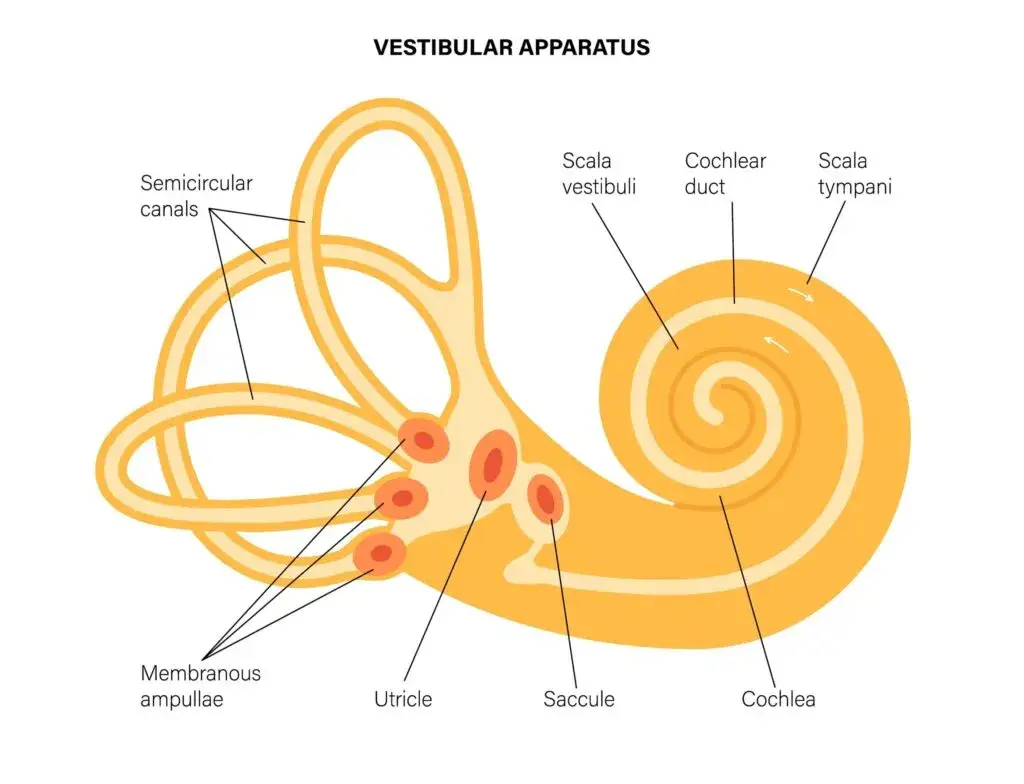
Top 15 FAQS about Vertigo: At Lavender Family Chiropractic in Sarasota, Florida, we understand how paralyzing vertigo can be. That relentless spinning sensation, accompanied by nausea, sweating, and a profound loss of balance, can shatter your confidence and diminish your quality of life. Many sufferers endure endless tests and treatments, only to have symptoms return unpredictably. While inner-ear disorders and neurological conditions are commonly blamed, a critical yet often overlooked culprit is misalignment in the upper cervical spine—specifically the atlas (C1) and axis (C2) vertebrae, which play a pivotal role in maintaining equilibrium.
Our dedicated team at Lavender Family Chiropractic combines cutting-edge diagnostics with a gentle, highly precise technique to address vertigo at its root. Using 3D Cone Beam Computed Tomography (CBCT) X-ray imaging, we visualize upper cervical alignment in three dimensions with sub-millimeter accuracy. Functional nervous system assessments via Tytron infrared thermography and surface electromyography reveal autonomic imbalances and compensatory muscle patterns. Armed with this comprehensive data, we deliver individualized Knee-Chest Upper Cervical (KC-UC) adjustments—no popping, twisting, or cracking—designed to restore proper alignment, optimize brainstem function, and abolish vertigo symptoms.
Below, we dive deeply into each of your top 15 FAQs about vertigo caused by upper cervical misalignment, expanding every section into focused, informative paragraphs. By the end, you’ll understand why our approach at Lavender Family Chiropractic is uniquely effective, what to expect during care, and how to reclaim your balance and life.
Top 15 FAQS about Vertigo and Understanding Upper Cervical Spine
Upper cervical chiropractic focuses exclusively on the top two vertebrae of the spine—the atlas (C-1) and axis (C-2). Though small, these bones sit directly beneath the brainstem and are crucial for normal nervous system function. At Lavender Family Chiropractic, we use state-of-the-art technology and gentle, precise techniques to detect and correct misalignments in the upper cervical spine. By restoring proper alignment, we help your body heal itself, reduce chronic pain, and improve overall wellness. Whether you’re dealing with migraines, neck pain, vertigo, or a host of other complex issues, upper cervical care can offer profound, lasting relief.
3D CBCT Imaging: Seeing Beyond the Surface
A cornerstone of our diagnostic process is three-dimensional cone beam computed tomography (3D CBCT). Unlike traditional X-rays, CBCT provides a full 360° view of your cranio-cervical junction. This cutting-edge imaging captures bone structures in high resolution, allowing us to pinpoint even the slightest atlas misalignment—sometimes measured in fractions of a millimeter. The clarity of CBCT:
- Eliminates guesswork.
- Reveals subtle asymmetries.
- Guides tailored adjustment plans.
With a comfortable, open-face design, our CBCT unit scans you in under 20 seconds, exposing you to minimal radiation—comparable to a few days of natural background exposure. This in-depth view empowers us to develop an exact treatment roadmap, ensuring each adjustment targets your unique needs.
Precision in Upper Cervical Adjustments
At Lavender Family Chiropractic, “precision” is more than a buzzword—it’s a promise. Our upper cervical technique employs gentle, non-invasive contacts, avoiding the twisting, popping, or cracking often associated with general chiropractic. Here’s how we maintain perfect accuracy:
- Custom Vector Analysis
Based on your CBCT data, we calculate the precise direction, depth, and angle needed to realign C-1 and C-2. - Specialized Instruments
Using ergonomic, lightweight tools, we deliver a measured impulse—akin to the force of dropping a nickel onto your palm. - Zero-Force Adjustments
In many cases, the contact required is so light you’ll barely feel it. This zero-force approach protects delicate structures around the brainstem. - Follow-Up Verification
After each adjustment, we re-evaluate alignment through palpation, neurological assessment, and periodic “check-up” CBCT scans when indicated.
Because upper cervical misalignments—even very small ones—can alter cerebrospinal fluid flow and nerve impulses, restoring alignment often yields swift improvements in pain, balance, and cognitive clarity.
Nervous System Scans & Tytron™ Functional Assessment
Understanding how your nervous system responds to a misalignment is key to tracking progress. That’s why we integrate Tytron™ paraspinal infrared thermography into our evaluation process. This non-invasive scan measures heat variations along the spine, which reflect autonomic nervous system activity. Key benefits include:
- Objective Baseline Data
We map temperature differentials along your cervical paraspinal muscles—identifying areas of inflammation or nerve irritation. - Treatment Monitoring
Comparing scans over time reveals how well your nervous system is rebounding post-adjustment. - Customized Care Plans
By correlating thermography findings with your symptoms, we fine-tune adjustment frequency and intensity.
In addition to Tytron™, we perform digital posture analysis and neurological reflex tests. Together, these modalities paint a holistic picture of your central and peripheral nervous systems, ensuring we address both the root cause and downstream effects of atlas misalignment.
Meet Our Expert Team
At Lavender Family Chiropractic, you’ll be cared for by a collaborative trio of doctors—all certified in upper cervical protocols:
- Dr. Rusty Lavender, D.C.
Founder and lead clinician, Dr. Lavender has over a decade of experience in Advanced HIO Knee-Chest Upper Cervical (AHKC) technique. His passion is helping patients reclaim active, pain-free lives through gentle, science-backed methods. - Dr. Jacob Temple, D.C.
A former biomedical researcher, Dr. Temple excels at integrating sophisticated imaging data into clinical practice. His meticulous attention to detail ensures each adjustment adheres strictly to your personalized vector plan. - Dr. Will Guzinski, D.C.
Skilled in patient education and functional neurology, Dr. Guzinski empowers individuals with tools—exercises, lifestyle modifications, and ergonomic strategies—to support spinal stability between visits.
Every member of our team takes time to listen to your story, understand your health goals, and explain findings in clear, jargon-free language. From front-desk support to clinical care, our staff is committed to a warm, welcoming environment where you feel heard, respected, and fully supported on your healing journey.
What to Expect: Your First Few Visits
- Initial Consultation & CBCT Scan
We’ll review your medical history and symptoms, then perform your 3D CBCT scan and full neurological exam. - Report of Findings
Within 24–48 hours, we sit down together to explain what we discovered, show your CBCT images, and outline your tailored care plan. - First Adjustment
During a follow-up visit, we perform your initial atlas adjustment, often followed by a light Tytron scan to gauge nervous system response. - Short-Term Re-Evaluation
Over the next 2–4 weeks, you’ll return for 2–3 check-ups. We verify alignment, monitor symptom changes, and adjust your schedule as needed. - Long-Term Maintenance
Once your atlas remains in place and symptoms stabilize, many patients transition to monthly or quarterly “tune-up” visits—helping sustain optimal health.
Most patients notice meaningful improvements within the first month: reduced headache frequency, better sleep, improved balance, and more energy. Because upper cervical care addresses the underlying cause of dysfunction, benefits typically endure far beyond the initial phase.
Real Results: Patient Experiences
- Migraines Resolved
“After years of monthly migraines, Dr. Lavender’s precise atlas adjustments ended my headaches for good. I can’t believe the difference!” - Vertigo Vanished
“I was told nothing could be done for my BPPV, but upper cervical care at Lavender Family Chiropractic stopped my spinning in its tracks.” - Enhanced Focus & Mood
“My brain fog lifted, and I finally felt like myself again. The nervous system scans made it clear my body was healing from the inside out.”
These are just a few examples of the life-changing outcomes our patients experience. Whether you’re an athlete aiming to optimize performance or someone simply seeking relief from chronic discomfort, our approach is designed to help you thrive.
Encouragement for Your Journey
Deciding to pursue upper cervical care is an investment in your long-term health and well-being. It’s natural to feel hopeful yet curious about what the process entails. Rest assured, you’ll be guided every step of the way by a team that truly cares. We celebrate your milestones—big and small—and empower you with knowledge and support.
If you’re ready to discover how gentle atlas adjustments, advanced CBCT imaging, and nervous system monitoring can transform your quality of life, we invite you to schedule a complimentary consultation. At Lavender Family Chiropractic, healing begins with precision, compassion, and gold-standard technology. Let us show you what truly personalized upper cervical care can achieve.
What Is Upper Cervical Chiropractic Care?
Upper cervical chiropractic care is a specialized subfield of chiropractic medicine focusing exclusively on the top two vertebrae of the neck: C1 (atlas) and C2 (axis). Unlike full-spine adjustments that rely on generalized thrusts, upper cervical care employs a data-driven, three-phase protocol:
- Precision Diagnostics: We begin with 3D CBCT imaging, which produces three-plane X-ray views, allowing us to measure minute atlas misalignments—including lateral shifts, rotational deviations, and anterior/posterior displacements. This replaces guesswork with objective, reproducible data.
- Functional Nervous System Assessment: Using the Tytron infrared thermography and surface EMG scans, we evaluate autonomic nervous system balance and muscle tone asymmetries along the cervical spine. These functional scans detect subtle heat variations and muscle tension that correlate with neural stress from misalignment.
- Tailored Adjustment: The Knee-Chest Upper Cervical (KC-UC) table positions you comfortably while we deliver a carefully calibrated, directional force to the atlas. This adjustment is gentle—no twisting or cracking—and aims solely for sub-millimeter correction, minimizing any risk while maximizing neurological restoration.
A final set of post-adjustment scans confirms the correction, ensuring your atlas remains aligned until the next check. We then equip you with targeted exercises, posture guidelines, and an individualized maintenance schedule to support lasting results.
Top 15 FAQs About Vertigo Caused by Upper Cervical Misalignment
1. How Can a Misaligned Atlas Trigger Vertigo?
The atlas (C1) sits at the base of the skull and carries half the weight of your head. It houses specialized mechanoreceptors that relay crucial data about head orientation to your vestibular centers. When C1 shifts even a fraction of a millimeter, it exerts abnormal stress on the brainstem and vertebral arteries, distorting proprioceptive signals. This mismatch between what your eyes see, what your inner ear senses, and the input from neck receptors creates the spinning, off-balance sensation known as vertigo.
2. How Is Atlas-Induced Vertigo Different from Inner-Ear Vertigo?
Inner-ear vertigo—such as BPPV—occurs when dislodged otolith crystals in the semicircular canals trigger brief, position-specific episodes of spinning. In contrast, atlantoaxial vertigo often presents as a more persistent or fluctuant dizziness that can intensify with minor head movements. Additionally, patients frequently report concurrent symptoms such as neck stiffness, cervicogenic headaches, or TMJ discomfort—clues pointing to cervical rather than labyrinthine origins.
3. What Diagnostic Tests Are Used in Upper Cervical Care?
At Lavender Family Chiropractic, our diagnostic arsenal includes:
- 3D CBCT Imaging: Offers sub-millimeter visualization of atlas and axis alignment in coronal, sagittal, and axial planes.
- Infrared Thermography (Tytron): Detects temperature differentials along the spine, indicating sympathetic nervous system stress.
- Surface EMG: Measures electrical activity in neck muscles, highlighting asymmetrical tension.
Combined, these tools generate a comprehensive structural and functional map, enabling us to craft a pinpoint adjustment strategy unique to your anatomy.
4. How Long Do Vertigo Symptoms Last Without Treatment?
Symptoms of untreated cervical misalignment can persist indefinitely, severely impacting quality of life. Acute misalignments—often triggered by trauma like whiplash or sports injury—can provoke intense vertigo lasting days to weeks. Chronic misalignments from repetitive strain or poor posture typically result in low-grade dizziness that may linger for months or years. Timely intervention with upper cervical care halts this cycle, shortening symptom duration and preventing long-term compensatory issues.
5. How Quickly Will I Notice Improvement?
Many patients experience discernible relief within 24 to 48 hours of their initial upper cervical adjustment. You may notice reduced spinning sensations, steadier gait, and diminished nausea. Complete neurological recalibration often unfolds over two to three visits spaced across one week. Each subsequent visit fine-tunes alignment, reinforcing neural pathways and accelerating recovery.
6. Is the Adjustment Painful?
Our Knee-Chest Upper Cervical technique is renowned for its comfort. The adjustment delivers a precise, low-force impulse—more akin to the gentle tap of a door-knocker than a forceful crack. Since we avoid twisting or high-velocity maneuvers, patients seldom feel discomfort. Many describe the experience as relaxing, often reporting an immediate sense of decompression and relief at the skull base.
7. How Many Visits Are Needed for Lasting Results?
While individual needs vary, a standard care plan often includes: two initial visits in the first week, one follow-up visit the following week, and biweekly visits thereafter until stabilization—usually totaling four to six visits in one month. Once your atlas remains aligned, we shift to maintenance visits every 4 to 6 weeks, or as guided by follow-up scans and symptoms.
8. Can Vertigo Recur After Treatment?
Yes—particularly if risk factors like poor ergonomics, heavy lifting, or repetitive strain persist. To minimize recurrence, we equip you with corrective exercises, ergonomic adjustments, and an individualized maintenance schedule. Many patients maintain symptom-free status for years, requiring only periodic check-ups.
9. Is Upper Cervical Chiropractic Safe?
Upper cervical chiropractic ranks among the safest manual therapies when performed by certified practitioners. Our diagnostic imaging ensures millimeter-level precision, and the gentle KC-UC adjustment eliminates high-velocity twisting. Peer-reviewed studies affirm both the efficacy and safety of atlas-specific care for cervical-related dizziness and headaches.
10. Can Children Suffer from Atlas-Induced Vertigo?
Absolutely. Children can misalign their atlas through birth trauma, falls, or sports. Even slight shifts can disrupt neurological feedback, leading to motion sensitivity, poor concentration, or balance issues. Pediatric adjustments use modified tables and minimal force to ensure comfort and safety, often yielding rapid improvements in coordination and focus.
11. How Does Upper Cervical Care Complement Vestibular Rehabilitation?
Vestibular rehabilitation focuses on retraining balance through exercises like gaze stabilization and habituation. While effective for peripheral inner-ear disorders, it does not correct cervical misalignments. By first realigning the atlas, upper cervical care restores accurate afferent input, enabling vestibular exercises to function optimally and preventing persistent symptom triggers.
12. What Role Does the Brainstem Play in Vertigo?
As the body’s central relay station, the brainstem integrates sensory input from the inner ear, eyes, and neck proprioceptors. Atlas misalignment irritates the brainstem’s vestibular nuclei, causing inaccurate signal processing. Correcting the alignment recalibrates these nuclei, resolving the neural mismatch that underlies vertigo.
13. Are Migraines and Vertigo Related in Atlas Misalignment?
Yes—studies show a high comorbidity between cervicogenic headaches and vestibular dysfunction. Misalignments place mechanical stress on the occipital nerves and vertebral arteries, triggering migraine pathways, while also distorting vestibular signals. Our holistic upper cervical approach often yields significant relief from both headaches and vertigo symptoms in one integrated treatment plan.
14. Do I Need Maintenance Adjustments?
To safeguard your progress, we recommend maintenance visits every 4 to 6 weeks after your initial care plan. These check-ups include quick CBCT or Tytron scans to verify atlas position and minor adjustments as needed. Some patients with robust postural habits transition to quarterly visits, ensuring ongoing neural integrity.
15. How Can I Schedule a Consultation at Lavender Family Chiropractic?
Ready to end your vertigo at the source? Call us at (941) 243-3729 or visit www.chiropractorsarasotaflorida.com to book your 3D CBCT imaging and comprehensive neurological assessment. Our clinic at 5899 Whitfield Ave, Suite 107, Sarasota, FL 34243, proudly serves Sarasota, Bradenton, Lakewood Ranch, Parrish, Ellenton, Venice, Osprey, Punta Gorda, St. Petersburg, Siesta Key, Longboat Key, Lido Key, and Myakka City.
Patient Testimonials
“After suffering daily vertigo for years, I finally experienced relief within 24 hours of my first atlas adjustment. Dr. Rusty’s approach is life-changing.” — Maria L., Sarasota, FL
“I never realized my neck alignment was the problem. Two precise adjustments later, my spinning sensations vanished.” — James R., Bradenton, FL
Conclusion & Call to Action
Vertigo from upper cervical misalignment is frequently misdiagnosed and inadequately treated, prolonging discomfort and fear. At Lavender Family Chiropractic, our advanced imaging, functional nervous system scans, and gentle Knee-Chest Upper Cervical adjustments target vertigo at its source—restoring proper neurological communication and balance.
Don’t let vertigo dictate your life any longer. Call (941) 243-3729 or visit www.chiropractorsarasotaflorida.com today to schedule your specialized atlas consultation. Reclaim your stability, confidence, and freedom—one gentle adjustment at a time.
Lavender Family Chiropractic in Sarasota Florida offers complimentary consultations to learn more about you. Click the link below!
https://intake.chirohd.com/new-patient-scheduling/724/lavender-family-chiropractic
We also service Bradenton, Parrish, Ellenton, Ruskin, Venice, Tampa, St. Pete, Osprey, Longboat, Lakewood Ranch, Myakka City.





